Study on the Application of Modified Sn-Based Solder in Cable Intermediate Joints
Abstract
1. Introduction
2. Materials and Methods
2.1. Method of Measuring Solder Properties
2.1.1. Alloy Material Preparation and Ratio
2.1.2. Melting Point Test
2.1.3. Electrical Performance Test
2.1.4. Mechanical Property Test
2.1.5. Wettability Test
2.2. Manufacture and Testing Methods of Cable Intermediate Joint
2.2.1. Manufacturing Method of Joint
2.2.2. Test Method for Intermediate Joints
3. Research Results and Analysis
3.1. Overview
3.2. Results of Performance Parameters of Solder
3.3. Effect of Temperature on Wettability of Solder
3.4. The Influence of the Change in Joint Structure Parameters on Its Performance
3.5. Effect of In Content on Joint Properties
4. Conclusions
- (1)
- Solder properties: The alloy solder is based on the Sn-1.5Cu system. By adding In to modify it, we found that with the increase in In the melting point decreases from 227.6 °C to 220.7 °C. The tensile strength of solder increases and can reach 57.18 Mpa when the content of In is 5%. The electrical conductivity of the solder increases slowly when the In content is 3.8%, and the solder conductivity reaches the maximum value of 3.236 × 106 S/m. When the In content is 3.8%, the wettability spreading area is the largest. The value is 93.05 mm2, and the wettability is 93.6%.
- (2)
- Joint manufacturing technology: In terms of joint size, we have studied a diameter range of 14 mm~18 mm, length range of 10 mm to 30 mm, welding temperature range of 230~280 °C, and welding gap of 0~4 mm. From the test results, the process is determined as follows: diameter: 16 mm, length: 30 mm, temperature: 250 °C, and welding gap: 1 mm.
- (3)
- Joint performance: The results show that the contact resistance of the joint decreases with the increase in In content, the contact resistance changes approximately linearly, and the minimum contact resistance is 7.05 μΩ when the In content is 5%. Compared with the aluminum hot-welded joint (12.39 μΩ), it has better electrical properties; the increase in In content in this range can improve the tensile strength of the joint, and the maximum tensile strength is 7174 N at 5%, which is close to 8797 N.
Author Contributions
Funding
Institutional Review Board Statement
Informed Consent Statement
Data Availability Statement
Conflicts of Interest
References
- Orton, H. Power cable technology review. High Volt. Eng. 2014, 41, 1057–1067. [Google Scholar]
- Czapp, S.; Szultka, S.; Ratkowski, F.; Tomaszewski, A. Risk of power cables insulation failure due to the thermal effect of solar radiation. Eksploat. Niezawodn. Maint. Reliab. 2020, 22, 232–240. [Google Scholar] [CrossRef]
- Guo, J.M.; Wang, F.F. Research on Cable Insulation Aging Under Acid-base Environment. E3S Web Conf. 2021, 261, 02053. [Google Scholar] [CrossRef]
- Kalinina, I.G.; Gumargalieva, K.Z.; Semenov, S.A.; Kazarin, V.V.; Zhdanova, O.A. Electrical Resistance of Non-Rigid Poly (Vinyl Chloride) Cable Insulation Infected by the Microscopic Fungus Aspergillus niger. Russ. J. Phys. Chem. B 2019, 13, 345–348. [Google Scholar] [CrossRef]
- Yang, W.; Xu, W.; Guo, X.; Yang, L. Musical Tone Law Method for the Structural Damage Detection. Adv. Mater. Sci. Eng. 2017, 2017, 8560596. [Google Scholar] [CrossRef]
- Chen, S.-R.; Xia, Y.-F.; Shao, X.-C.; Jia, Z.-D.; Wang, X.-L.; He, B. Analysis and countermeasure of 110 KV cable joint defects. In Proceedings of the 2019 IEEE 3rd Conference on Energy Internet and Energy System Integration (EI2), Changsha, China, 8–10 November 2019; pp. 2342–2345. [Google Scholar]
- Swati, S.C.; Zhou, C.-K.; Bevan, G.; Alkali, B. Prediction of power cable failure rate based on failure history and operational conditions. In Proceedings of the 9th International Conference on Insulated Power Cables, Versailles, France, 21–25 June 2015. [Google Scholar]
- Ojha, G.; Roy, A.; Verma, R.; Kumar, V. Underground cable fault distance locator. Int. J. Adv. Res. Ideas Innov. Technol. 2019, 4, 17–20. [Google Scholar]
- Zhao, A.-Q.; Gu, L. Study on the temperature distribution of the outer surface of the cable intermediate joint based on ANSYS simulation. In Proceedings of the 2018 IEEE 4th Information Technology and Mechatronics Engineering Conference (ITOEC), Chongqing, China, 14–16 December 2018; pp. 20–23. [Google Scholar]
- Wang, Q.; Yang, Q.; Hu, X.-R.; Fu, J.; Chen, W.; Yang, F. Simulation and analysis of propagation characteristics of partial discharge signal in XLPE cable joint. In Proceedings of the 2016 IEEE 11th Conference on Industrial Electronics and Applications (ICIEA), Hefei, China, 5–7 June 2016; pp. 2232–2235. [Google Scholar]
- Wang, H.-Y.; Li, Z.-L.; Zhou, S.-F.; Fan, M.-S.; Wu, Y.; Du, B.-X.; Yang, Z.-R. Relationship between electrical treeing degradation and DCIC-Q(t) characteristics of XLPE insulation. In Proceedings of the 2022 IEEE 4th International Conference on Dielectrics (ICD), Palermo, Italy, 3–7 July 2022; pp. 589–592. [Google Scholar]
- Moustaf, G.; Elmaksoud, T.A. Evaluation of the joint resistance of compressed connectors in aluminum cables. Port Said Eng. Res.J. 2020, 19, 114–120. [Google Scholar] [CrossRef]
- Mohd, R.M.M.; Huzainie, S.A.H.; Ahmad, B.A.G. Study of cable crimping factors affecting contact resistance of medium voltage cable ferrule and lug. In Proceedings of the 22nd International Conference on Electricity Distribution, Stockholm, Sweden, 10–13 June 2013; p. 1017. [Google Scholar]
- Yang, F.; Liu, K.; Cheng, P.; Wang, S.; Wang, X.; Gao, B.; Fang, Y.; Xia, R.; Ullah, I. The Coupling Fields Characteristics of Cable Joints and Application in the Evaluation of Crimping Process Defects. Energies 2016, 9, 932. [Google Scholar] [CrossRef]
- Jongwuttanaruk, K.; Thavornwat, C. Optimization of mechanical crimping in the cerminal crimping process using a response surface methodology. Adv. Mater. Sci. Eng. 2022, 2022, 6508289. [Google Scholar] [CrossRef]
- Li, C.X.; Du, J.; Chen, D.; Zhou, Y.; Wang, X.M.; Yao, C.G. Development and experimental study of cable joint pressure connecting device based on the electromagnetic pulse forming technology. High Volt. Eng. 2020, 46, 2941–2950. [Google Scholar] [CrossRef]
- Li, F.; Jiang, J.; Cheng, H.; Xu, J.; Ge, X.; Li, H.; Zhao, J.; Ran, Y. Optimization of the Field Shaper Parameters in Electromagnetic Pulse Crimping of Cable. Int. J. Precis. Eng. Manuf. 2021, 22, 1693–1706. [Google Scholar] [CrossRef]
- Riyani, P.D.; Saepul, R. Persebaran medan listrik akibat proses exothermic welding pada kabel tegangan menengah 20 kV. Media Komun. Ilm. Politek. Cilacap 2021, 12, 22–27. [Google Scholar]
- Laurila, T.; Vuorinen, V.; Kivilahti, J.K. Interfacial reactions between lead-freesolders and common base materials. Mater. Sci. Eng. 2005, 49, 1–60. [Google Scholar] [CrossRef]
- Laurila, T.; Vuorinen, V.; Paulasto-Kröckel, M. Impurity and alloying effects on interfacial reaction layers in Pb-free soldering. Mater. Sci. Eng. R Rep. 2010, 68, 1–38. [Google Scholar] [CrossRef]
- Abtew, M.; Selvaduray, G. Lead-free solders in microelectronics. Mater Sci. Eng. R Rep. 2000, 27, 95–141. [Google Scholar] [CrossRef]
- Kotadia, H.R.; Howes, P.D.; Mannan, S.H. A review: On the development of low melting temperature Pb-free solders. Microelectron. Reliab. 2014, 54, 1253–1273. [Google Scholar] [CrossRef]
- Zeng, G.; Xue, S.; Zhang, L.; Gao, L. Recent advances on Sn–Cu solders with alloying elements: Review. J. Mater. Sci. Mater. Electron. 2011, 22, 565–578. [Google Scholar] [CrossRef]
- El-Daly, A.A.; Hashem, H.A.; Radwan, N.; El-Tantawy, F.; Dalloul, T.R.; Mansour, N.A.; Abd-Elmoniem, H.M.; Lotfy, E.H. Robust effects of Bi doping on microstructure development and mechanical properties of hypoeutectic Sn–6.5Zn solder alloy. J. Mater. Sci. Mater. Electron. 2015, 27, 2950–2962. [Google Scholar] [CrossRef]
- Faizov, S.; Sarafanov, A.; Erdakov, I.; Gromov, D.; Svistun, A.; Glebov, L.; Bykov, V.; Bryk, A.; Radionova, L. On the Direct Extrusion of Solder Wire from 52In-48Sn Alloy. Machines 2021, 9, 93. [Google Scholar] [CrossRef]
- Yang, C.-H.; Zhou, S.; Lin, S.-K.; Nishikawa, H. A Computational Thermodynamics-Assisted Development of Sn-Bi-In-Ga Quaternary Alloys as Low-Temperature Pb-Free Solders. Materials 2019, 12, 631. [Google Scholar] [CrossRef]
- Hua, F.; Mei, Z.; Lavagnino, A. Eutectic Sn–Bi as an alternative Pb-free solder. In Proceedings of the 48th Electronic Components and Technology Conference (Cat. No.98CH36206), Seattle, WA, USA, 25–28 May 1998. [Google Scholar]
- Islam, M.N.; Chan, Y.C.; Rizvi, M.J.; Jillek, W. Investigations of interfacial reactions of Sn–Zn based and Sn–Ag–Cu lead-free solder alloys as replacement for Sn–Pb solder. J. Alloys Compd. 2005, 400, 136–144. [Google Scholar] [CrossRef]



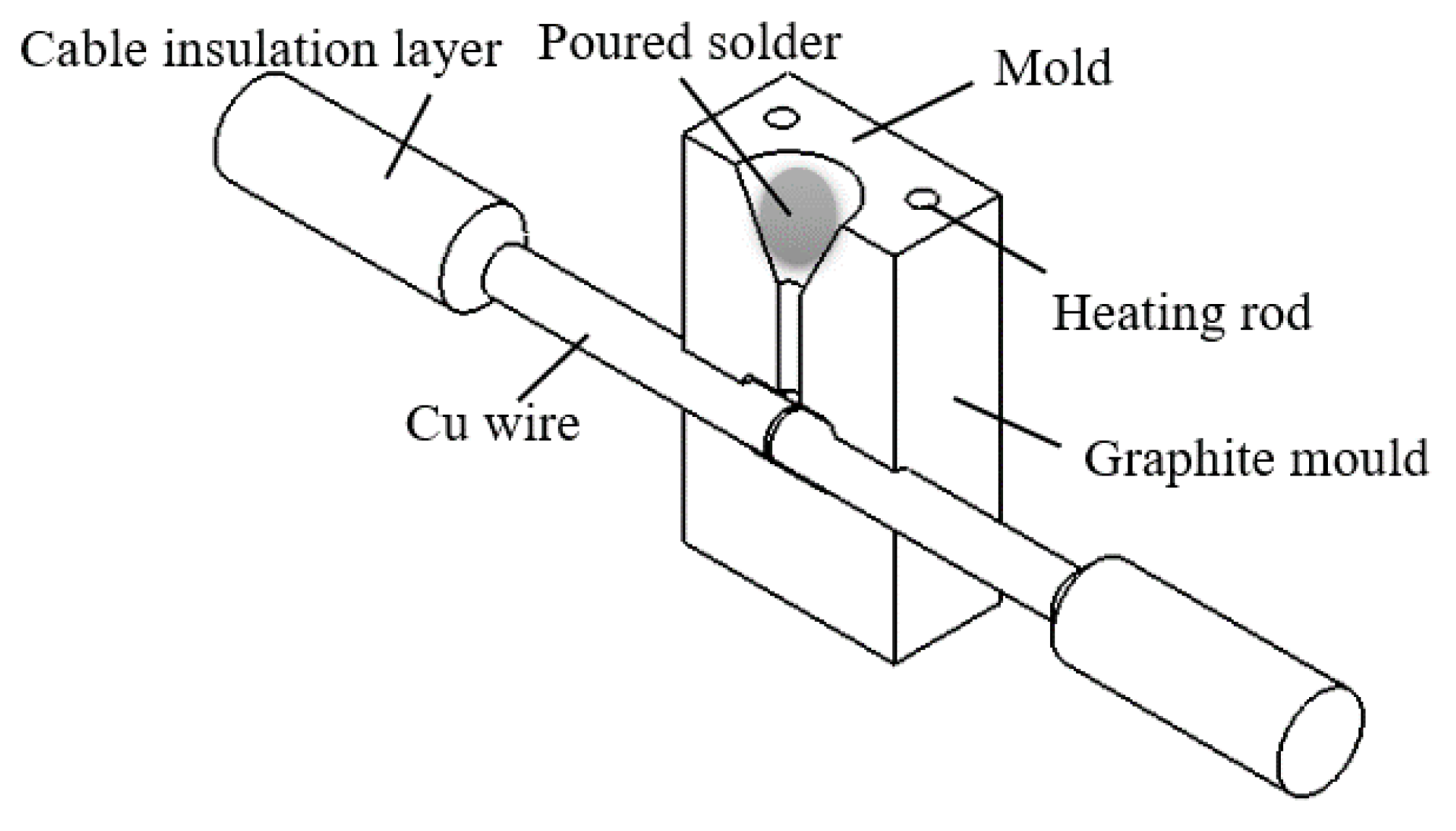

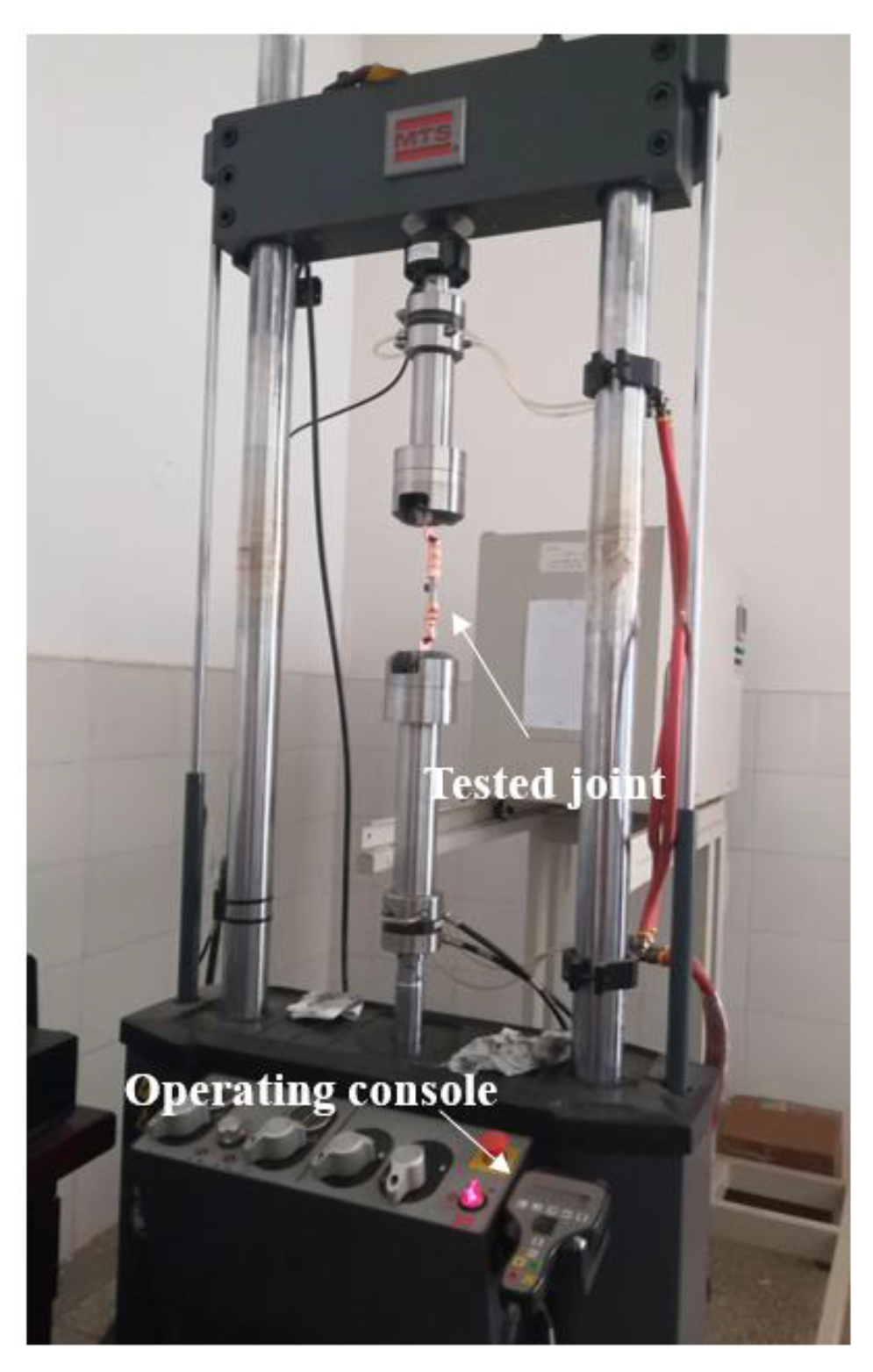


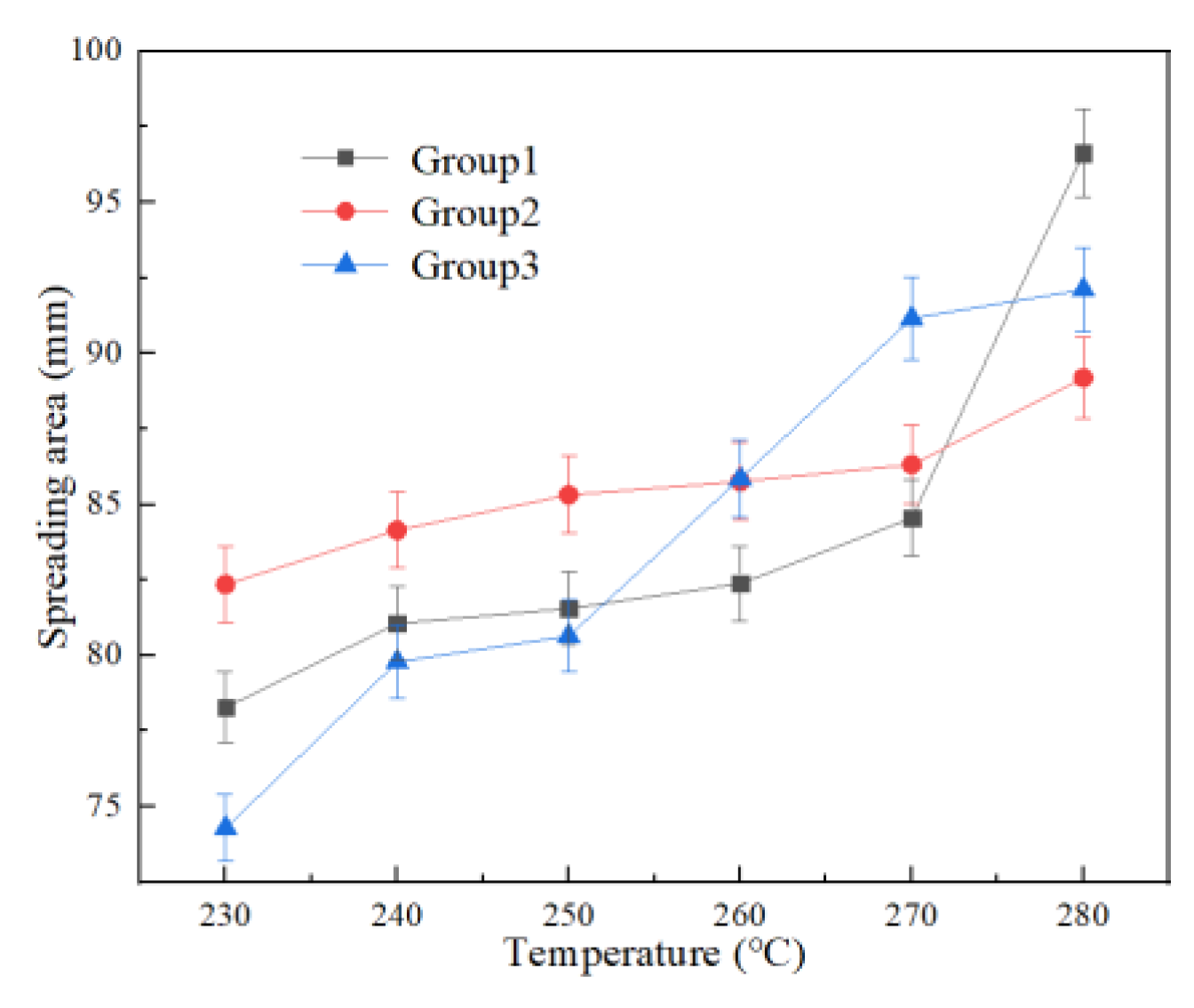
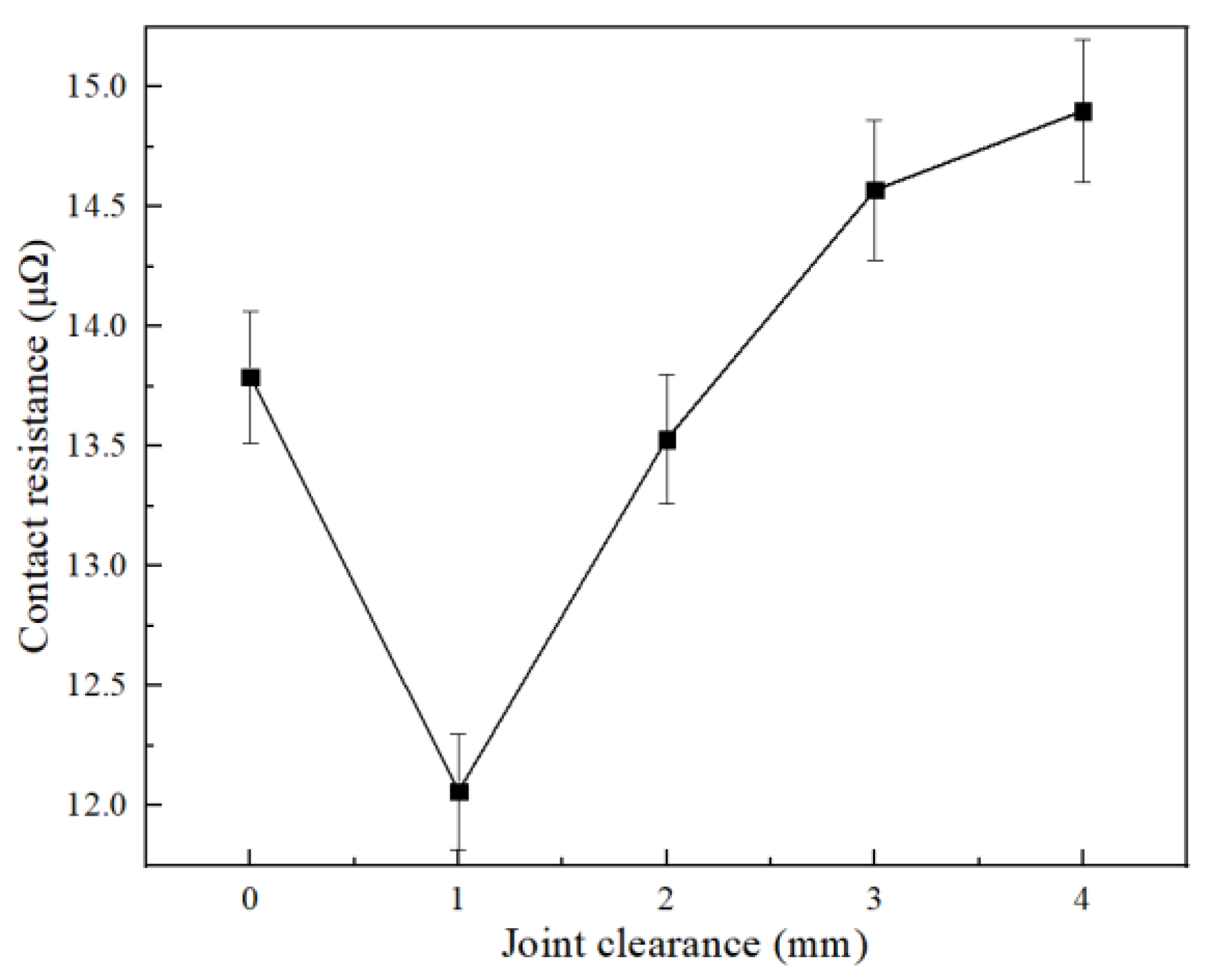


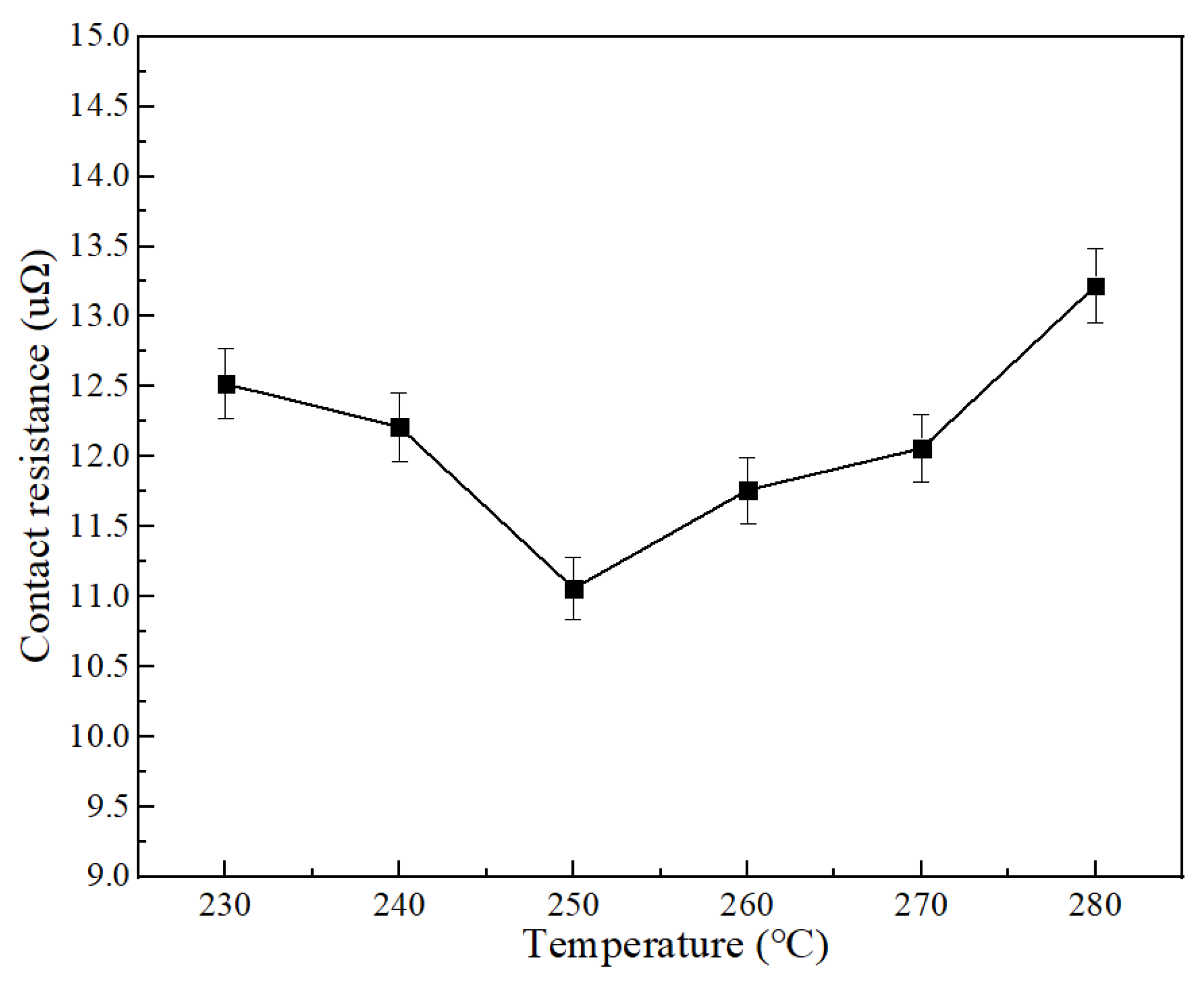

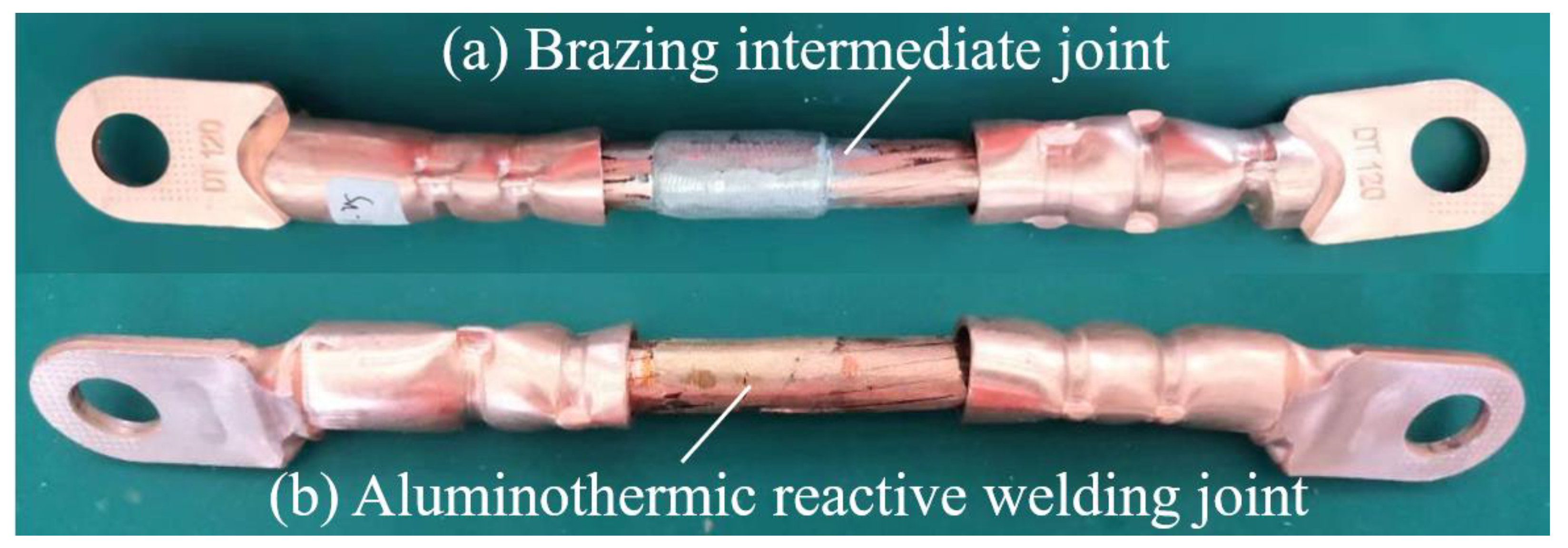
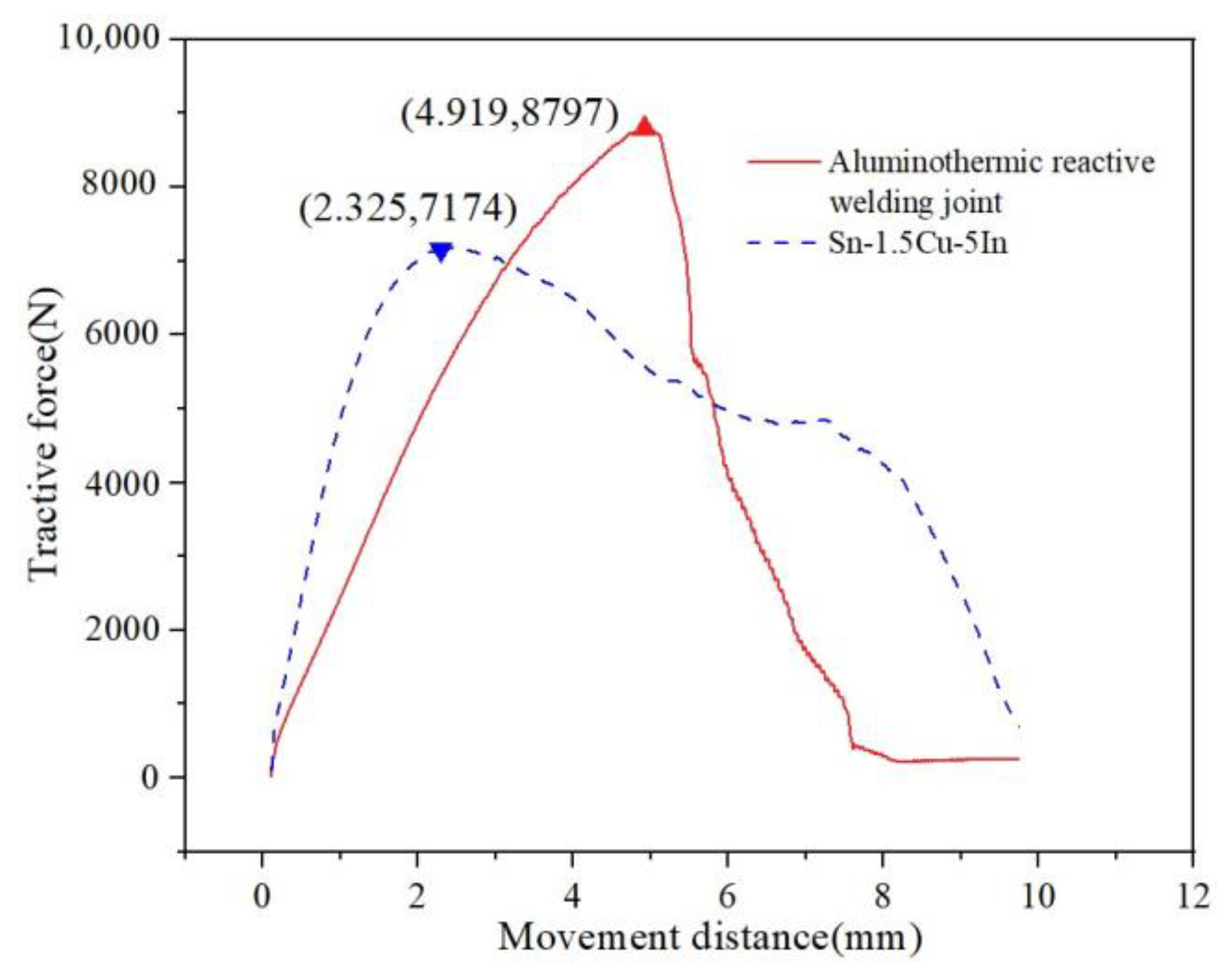
| Alloy Composition | Sn (g) | In (g) | Cu (g) |
|---|---|---|---|
| Sn-1.5Cu-0.8In | 97.7 | 0.8 | 1.5 |
| Sn-1.5Cu-2In | 96.5 | 2 | 1.5 |
| Sn-1.5Cu-2.8In | 95.7 | 2.8 | 1.5 |
| Sn-1.5Cu-3.8In | 94.7 | 3.8 | 1.5 |
| Sn-1.5Cu-5In | 93.5 | 5 | 1.5 |
| Alloy Composition | Melting Point (°C) | Melting Range (°C) | Tensile Strength (MPa) | Electric Conductivity (S/m) | Spreading Area (mm2) | Wetting Rate (%) |
|---|---|---|---|---|---|---|
| Sn-1.5Cu | 232.4 | 4.7 | 20.54 | 2.841 × 106 | 49.88 | 87.6 |
| Sn-1.5Cu-0.8In | 227.6 | 4.1 | 37.50 | 2.224 × 106 | 58.19 | 89.4 |
| Sn-1.5Cu-2In | 225.5 | 3.5 | 41.92 | 2.387 × 106 | 67.53 | 90.7 |
| Sn-1.5Cu-2.8In | 224.3 | 2.9 | 43.86 | 2.532 × 106 | 85.65 | 92.1 |
| Sn-1.5Cu-3.8In | 223.0 | 2.4 | 52.31 | 3.195 × 106 | 93.05 | 93.6 |
| Sn-1.5Cu-5In | 220.7 | 2.0 | 53.18 | 3.236 × 106 | 92.64 | 93.3 |
| Joint Category | Contact Resistance (μΩ) |
|---|---|
| Copper wire | 7.88 |
| Sn-1.5Cu | 15.90 |
| Sn-1.5Cu-0.8In | 14.37 |
| Sn-1.5Cu-2In | 12.16 |
| Sn-1.5Cu-2.8In | 10.73 |
| Sn-1.5Cu-3.8In | 7.59 |
| Sn-1.5Cu-5In | 7.05 |
| Aluminothermic reactive welding joint | 12.39 |
| Joint Category | Maximum Pulling Force (N) |
|---|---|
| Sn-1.5Cu-0.8In | 6082 |
| Sn-1.5Cu-2In | 6217 |
| Sn-1.5Cu-2.8In | 6435 |
| Sn-1.5Cu-3.8In | 6810 |
| Sn-1.5Cu-5In | 7174 |
| Aluminothermic reactive welding joint | 8797 |
Publisher’s Note: MDPI stays neutral with regard to jurisdictional claims in published maps and institutional affiliations. |
© 2022 by the authors. Licensee MDPI, Basel, Switzerland. This article is an open access article distributed under the terms and conditions of the Creative Commons Attribution (CC BY) license (https://creativecommons.org/licenses/by/4.0/).
Share and Cite
Zhang, W.; Luo, R.; Wu, X.; Xu, C.; Suo, C. Study on the Application of Modified Sn-Based Solder in Cable Intermediate Joints. Materials 2022, 15, 8385. https://doi.org/10.3390/ma15238385
Zhang W, Luo R, Wu X, Xu C, Suo C. Study on the Application of Modified Sn-Based Solder in Cable Intermediate Joints. Materials. 2022; 15(23):8385. https://doi.org/10.3390/ma15238385
Chicago/Turabian StyleZhang, Wenbin, Ruikang Luo, Xuehua Wu, Chungang Xu, and Chunguang Suo. 2022. "Study on the Application of Modified Sn-Based Solder in Cable Intermediate Joints" Materials 15, no. 23: 8385. https://doi.org/10.3390/ma15238385
APA StyleZhang, W., Luo, R., Wu, X., Xu, C., & Suo, C. (2022). Study on the Application of Modified Sn-Based Solder in Cable Intermediate Joints. Materials, 15(23), 8385. https://doi.org/10.3390/ma15238385










